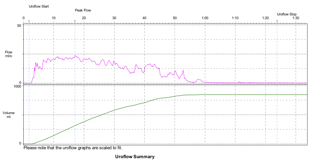 How can we gauge the current level of diagnostic utility of uroflowmetry? Are there areas needing research to improve it? This study was performed to verify the diagnostic value of uroflowmetry, its flaws, to discuss gaps in knowledge, and to provide areas where further research is necessary.
How can we gauge the current level of diagnostic utility of uroflowmetry? Are there areas needing research to improve it? This study was performed to verify the diagnostic value of uroflowmetry, its flaws, to discuss gaps in knowledge, and to provide areas where further research is necessary.
What is uroflowmetry?
Uroflowmetry is a non-invasive, cost-effective, simple test for the assessment of urine flow rate. In fact, it is recommended as the first choice of investigation to be done in all patients with signs and symptoms of lower urinary tract (LUT) dysfunction by the American Urological Association (AUA) and European Urology Association (EAU). Although such a recommendation is undisputed, there is a lot of ambiguity in the interpretation of the parameters in the test and its diagnostic value, due to a lack of adequate research data.
Maximum flow rates
The main use of this test is its ability to provide an estimation of the likelihood of bladder outflow obstruction (BOO) in male patients. The flow rate depends on both outflow diameter and intravesical pressure and on Qmax. Most authorities, including AUA or EAU guidelines comment that the diagnostic accuracy of uroflowmetry to diagnose BOO varies considerably and it is substantially influenced by the threshold values. Large scale studies conducted, such as ICS-‘BPH’, reported that lower Qmax thresholds are more specific to diagnose BOO, but less sensitive and when the threshold is raised the sensitivity increases but specificity decreases.
There was a trade-off between sensitivity and specificity as the different flow rates are considered. In women, researchers found flow rates which are generally higher than their male counterparts and this is why the specificity is lower when establishing the diagnosis of BOO. In addition to maximum flow rate, other signs and symptoms, age and gender need to be combined to diagnose LUT.
Multiple Uroflow Measurements
Uroflowmetry is affected by many factors. It is advised that serial uroflowmetry measurements, which are consistently similar and comparable, provide the most valuable information for the diagnosis. The general recommendation is that a patient should be estimated with a urine volume >150mL and with serial measurements.
Flow-Volume Nomograms
Nomograms are graphs that allow for correction of flow rate. However, their utility in the diagnosis is not strong. They cannot provide a precise urodynamic diagnosis but can indicate the probability of normality of maximum flow rate. Their applicability is limited in the initial screening and in the treatment outcome. Nevertheless, the sensitivity, specificity, type of volume measured, and the influence of age and population type for each nomogram can be more clearly described and understood.
Flow rate curve shape
The terms used to describe the shape of the urine flow rate curve vary. The shape of the curve can serve as a guide to the existence of an identifiable dysfunction which can vary considerably due to many factors, such as the technical performance of the test, patient inhibition, unrepresentative voiding which can lead to erroneous attributions and to LUT dysfunction.
The terms “staccato-shaped”, “interrupted-shape” used in describing the curve are more inclined to tell the cause of the shape rather than express the shape themselves. Therefore, consistency and clarity in description requires a full analysis of diagnostic utility of uroflowmetry.
Uroflow time measurements
ICS-‘BPH’ defines flow time as ‘the time over which measurable flow actually occurs.’ But the threshold above which the flow is considered measurable is not defined. And the equipment sensitivity will therefore affect the time value recorded. It has been suggested that BOO in men could be improved by considering the time from Qmax to the point were 95% of voided volume had been voided but this has not been confirmed.
Other measurements alongside uroflow
Flow lag time can be used as an aid in watching the progress of management, however it can vary since the size of the meatus to flowmeter distance has not been carried out. Pelvic floor dysfunction can be a cause for irregular voiding in adults but there is no supportive evidence.
Abdominal pressure can have variable effects on the flow rate and it is reasonable to suggest that a non-invasive synchronous recording of the abdominal pressure to be investigated in different patient groups.
Areas for research
Studies to be carried out to address the following research questions:
- Can the maximum flow rate be improved as a diagnostic criteria for adult women and young adult men?
- Which definition of voiding dysfunction would be best applicable in clinical practice?
- What (clinical) signs or symptoms can be combined with uroflowmetry to enhance its diagnostic power?
- Should an adult EMG—uroflowmetry test be designed?
- Should an abdominal pressure—uroflowmetry test be designed?
- How can the normalization of flow rate to volume be improved, and nomograms consequently standardized?
- How can urine flow curve shape analysis be standardized, quantified, and better associated with voiding dysfunctions?
- How can multiple flows and home uroflowmetry be applied to increase diagnostic accuracy?
- How can thresholds and protocols for measuring urine flow time be more clearly defined?
Conclusion
There is a need for research to combine uroflowmetry with other non-invasive indicators. Better standardization of test technique, flow-volume nomograms, uroflow shape descriptions, and time measurements are required.
If you need staffing assistance with urodynamics or uroflowmetry, click the button below to receive a brochure detailing BHN's uroflowmetry and urodynamics staffing options.


